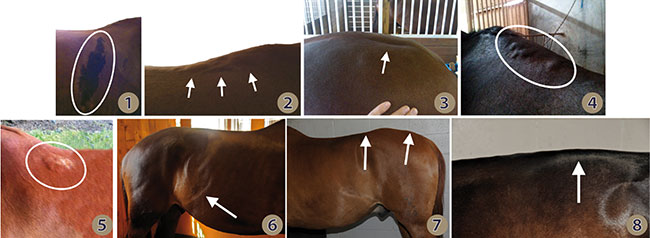
The goal of saddle fitting is to prevent discomfort, behavioral issues and damage by avoiding pressure on reflex points and distributing the rider’s weight optimally over the saddle support area. Listen to what your horse is trying to tell you and make sure your saddle is checked regularly for proper fit!
In my book Suffering in Silence – the Saddle Fit Link to Physical and Psychological Trauma in Horses, Dr. Carol Vischer DVM (certified in acupuncture and spinal manipulation) contributed an article The Horse’s Skin is a Good Indicator of Pain. Dr. Vischer states: “I hope through education, more owners become cognizant of the damage that inevitably occurs from chronic pressure.” Some of these indications are illustrated further down, but once your horse has developed blisters, bumps, and white hairs, you should have already received the cry for help. These things show up after the damage has already been done – much like you get blisters from wearing shoes that don’t fit. You recognize they don’t fit pretty early on; feel the pain (or work through it); but when you take them off – there’s the blister!
A horse’s sense of touch is much more sensitive than a human’s. Think about the reaction when a fly lands – which weighs really nothing when you think about it, and yet the horse flicks a muscle to get rid of the feeling. It stands to reason that the horse will notice the slightest pressure and react to subtle weight changes when the rider gives an aid. It’s almost like the princess with the pea – and consider how painful it must be to have a lump in the panel flocking that continually presses into its back. If a horse seems to ignore an aid it might be a training issue (unclear about what’s expected) or because the saddle has been putting constant pressure on a reflex point, and he has become ‘deadened’ to the touch. The saddle (as interface between horse and rider) has the potential to inflict the most anatomical and physiological damage when it no longer fits.
I have often had riders tell me, “I just have to warm him up for about 15 minutes before you can assess him”. But what that tells me is that the horse actually has to be ridden in order to get accustomed to some sort of saddle pressure and get used to the pain – in other words, become numb to something that doesn’t fit in order to allow me to do my job.
Cartilage chipping, nerve pinching, subluxated vertebrae, tongue problems are a few of the issues which can lead to further behavioral and psychological damage – beyond the physiological – making it next to impossible for horse and rider to find harmony because the horse is fighting the saddle. These pictures demonstrate some of the irreversible damages – the result of badly fitting saddles.
1. Sweat marks come from damaged sweat glands caused by inappropriate girthing and an incorrect billet system.
2. Vertebral and spinal ligament damage caused by too much pressure on the spinal processes.
3. A saddle that was too long and incorrect training results in abnormal development of the loin muscle area.
4. The muscular development at the loins was due to the gullet channel that was too narrow. You don’t want this ‘dip’at the croup, but rather a nice, evenly rounded rump.
5. White marks caused by either a saddle pad that was too thick or made of synthetic materials that cannot breathe.
6. Constant muscular contraction results in incorrect definition of the flank. This can be caused by the saddle sitting on the withers or pressing down on the spinal column.
7. Visible results from the saddle that is too long for the horse, exerting too much pressure at and behind the 18th lumbar vertebra.
8. Subluxation of lumbar vertebrae as a result of pressure at CN11, causing the horse to instinctively block his movement, yet still responding to the rider’s impulse to move forward (similar to driving a car with the hand brake on). The horse moves forward reluctantly with damage that may show up later.
~ Jochen Schleese CMS, CSFT, CSE, courtesy of Saddlefit 4 Life
